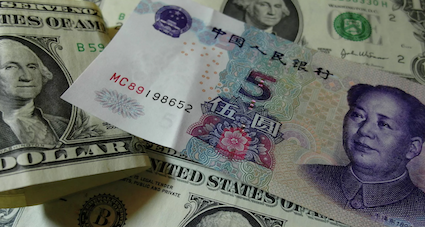It’s not just Russia with which India is trading with Indian rupees: Importers from Russia, Iran, the United Arab Emirates (UAE), Saudi Arabia, Japan and several other non-western states have expressed interest in paying for Indian exports in rupees.
Most of it has to do with the rising Dollar which has hit other currencies of the world massively. Most nations are looking to lessen its usage so as to help their economies.
There are some other improvisations at work too: Indian businesses have received massive discount from China to settle their transactions in Yuan, resulting in huge saving on their imports against the backdrop of elevated commodity prices. In particular, India’s steel and cement companies have benefitted most from the Chinese offer, according to the sources.
“Indian firms dealing in the cement and steel sector received a 15 percent discount on Chinese Yuan. They found it lucrative, given the Rupee depreciation and settle their transactions in the Chinese currency with Russia,” an official in New Delhi told Sputnik.
Steel and cement manufacturers have imported Russian coal at discounted rate while prices remain elevated in other alternative markets such as Indonesia and Australia.
India has imported over 8 million tons of Russian coal since March.
“Chinese and Indian currency depreciated against the US dollar by 7 percent this year. The 15 percent discount on Yuan against the prevailing market price of US dollar provided businesses with dual relief as we have also minimized the Rupee depreciation against the dollar,” said a trader.
The depreciation of the rupee against the US dollar makes imports costlier for the Indian businesses.
As a result, those dealing in heavy machinery and pharma are also negotiating with China for Yuan settlements for Russian transactions.
Traders said the yuan could be increasingly used to settle payments for Russian supplies.
“China’s intervention in currency market is only challenge before Yuan to remain preferred choice for the settlement. “ the trader said.
Meanwhile, India and Russia have been engaged in making permanent arrangements for the Rupee-Ruble payment of their booming bilateral trade.
This year, India’s bilateral trade with Russia increased to nearly double by August compared to the annual trade value of 2021 with oil imports from Russia alone constituting $8.95 billion between April-July.
The development comes as major global currencies are hit vis-a-vis the US dollar as the Federal Reserve hiked interest rates on dollar bonds last week in a bid to check inflation, which has been caused by surging fuel and food prices in the wake of western sanctions against Russia.
Prabir Bhattacharjee, secretary-general of the Indian industry group Tea Association of India, told Sputnik that importers from countries such as Russia and Iran, which have been hit by western sanctions, are seeking to institutionalize the arrangement to pay for Indian goods in rupees in order to bypass economic restrictions.
“This move will be particularly helpful for the Indian tea industry, where both Russia and Iran are top two tea importing countries,” he said.
Bhattacharjee also explained that importers from other major tea-importing countries, such as the UAE, Saudi Arabia, Japan, Sri Lanka and China, were also expected to benefit from paying for Indian exports in rupees as a rising US dollar takes its toll on currencies worldwide.
The Tea Association of India represents companies that account for 60 percent of the country’s overall production of the beverage. As per government statistics, India was the second biggest producer of tea and the fourth-biggest exporter globally last year.
According to the Tea Board of India, an organization under the Ministry of Commerce, nearly 17.3 percent of India’s tea exports in 2021 were shipped to Russia, while 13.4 percent were sent to Iran. The UAE accounted for around 8.8 percent of Indian tea exports in 2021, a figure that is expected to rise this year.
Ashwani Mahajan, the co-convenor of the Indian economic advocacy group Swadeshi Jagran Manch (SJM), told Sputnik that it is “desirable” for New Delhi to look for alternatives to the US dollar in carrying out foreign trade.
“It is the need of the hour,” said Mahajan, as he expressed confidence that foreign trading in rupees could expand in coming months and years.
Mahajan blamed western sanctions against Iran and then Russia as the “trigger” for Delhi’s push away from the US dollar. The expert, however, feels that India should have encouraged the practice of trading in local currencies several decades earlier.
Tehran was one of Delhi’s biggest energy suppliers before Washington withdrew from the Joint Comprehensive Plan of Action (JCPOA), also known as the Iran deal, in 2018 and imposed harsh economic sanctions on the Islamic Republic, which affected the country’s economic ties with New Delhi as well.
“Why didn’t it take place earlier, perhaps in the late 1990s, when the western nations threatened India with sanctions after we carried out nuclear bomb tests,” he wondered.
“While what course this move away from the dollar takes will only be decided in the future, I strongly feel it is a very feasible method which would help India in achieving self-reliance.”
Mahajan also reckoned that moving towards a rupee-trading system would prove “profitable” for the global expansion of Unified Payments Interface (UPI), an Indian government-backed payments system that is meant to serve as an alternative to the western SWIFT system.
He also mentioned that the ongoing push to internationalize the Indian rupee would benefit from the proposed central banking digital currency (CBDC), or a digital tender issued by the Reserve Bank of India which could pilot in the coming months.
(This piece is taken with gratitude from The Sputnik News)


